

Among all festivals in China, the Spring Festival is the most important. It symbolizes a farewell to the past and a greeting to the new one. Celebration of the Spring Festival features a blend of folk rituals and customs and encapsulates people’s gratitude for their family, and veneration for ancestors and Nature.
Although the Lunar New Year officially starts from the first day of the Lunar January, the festive vibe of the Spring Festival can normally be felt strongly early in Lunar December. Lunar December, known as La Yue in Chinese, marks the end of the lunar year. According to tradition, the term La Yue originates from the ancient La Ji (腊祭), a winter ritual where offerings were made to ancestors by sacrificing animals. Simultaneously, there was the homophonous La Ji (蜡祭) dedicated to the god of all grains. Over time, these two rituals were merged, signifying prayers for a bountiful harvest and blessings for the upcoming new year. The month in which these ceremonies took place came to be known as La Yue.
In this poster, join us on a journey to explore the unique charm of the kaleidoscopic customs of Chinese Lunar New Year .

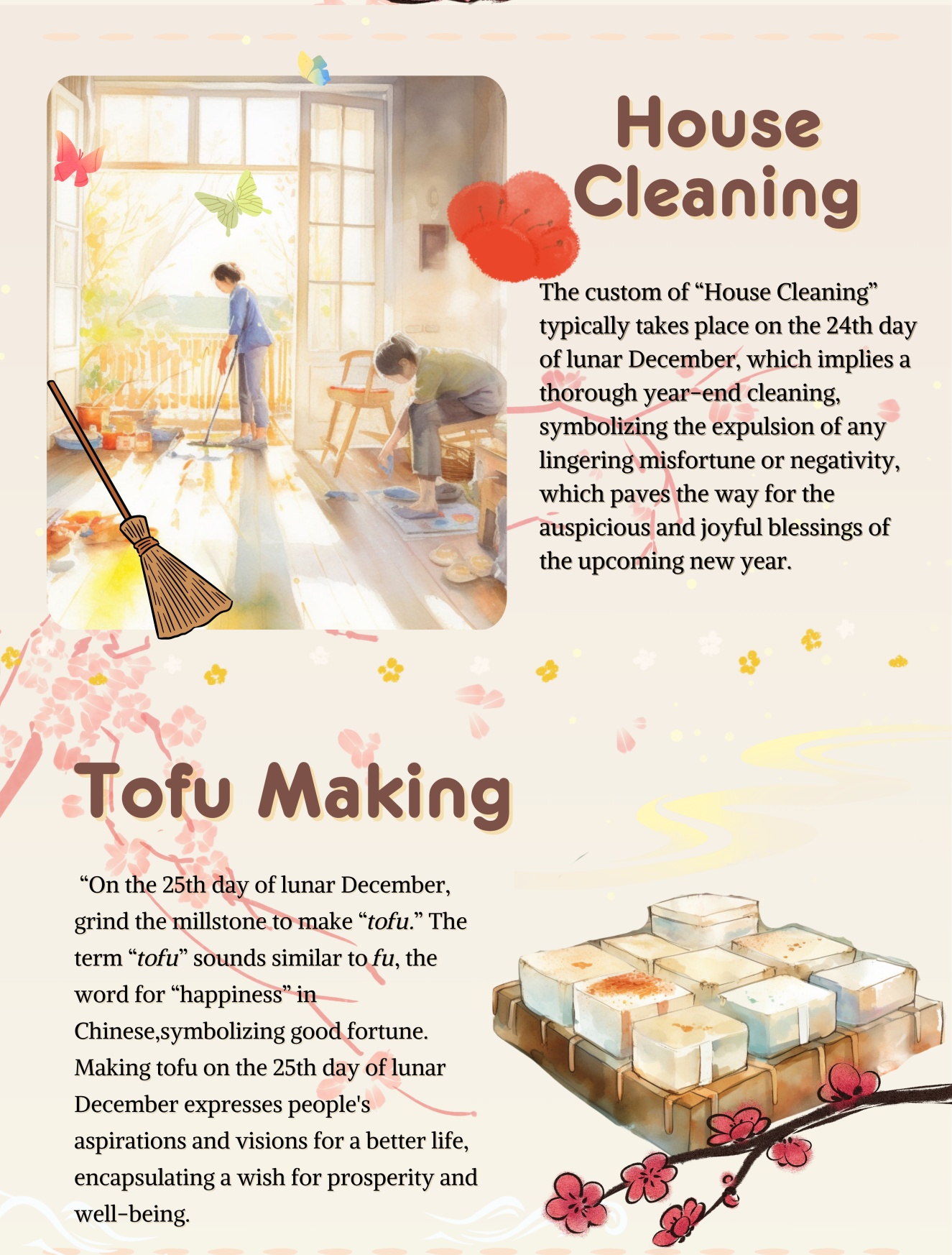
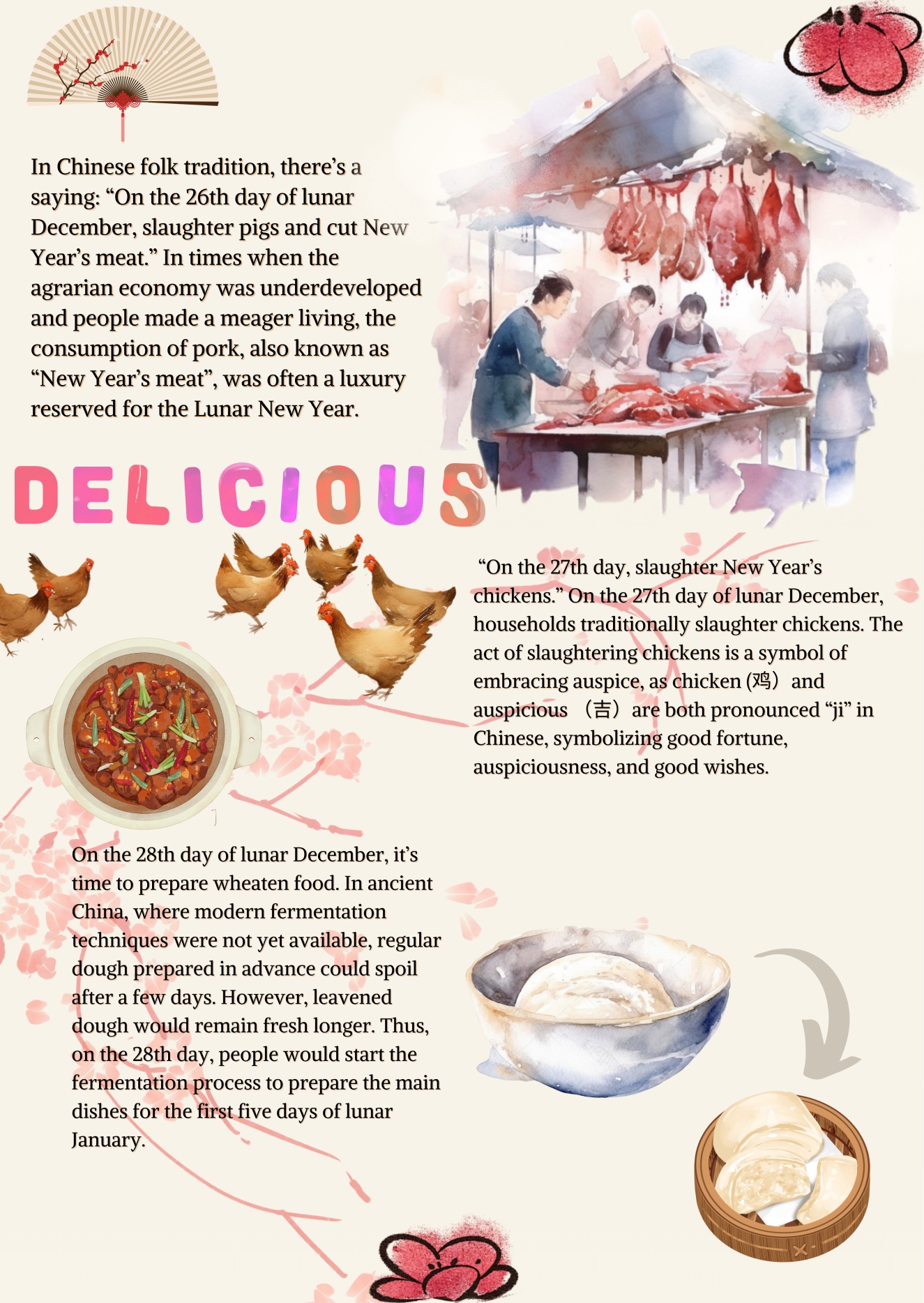




Laba Porridge– On the eighth day of lunar December, China observes the Laba Festival, which is associated with consuming Laba Porridge. This porridge typically comprises glutinous rice, sesame seeds, coix seeds, longans, red dates, shiitake mushrooms, lotus seeds, and other ingredients, symbolizing the abundance of grains and the forthcoming happiness and auspiciousness in the new year.
Xiao Nian– The 23rd or 24th day of lunar December is known as Xiao Nian or “Minor New Year.” The specific date may vary slightly based on regional customs. On this day, besides partaking in the Reunion Dinner, a crucial tradition is the “Providing Offerings to Kitchen God.” According to legend, the Kitchen God is a celestial official delegated by the Jade Emperor to oversee the hearths of each household. On the 23rd day of lunar December, the Kitchen God ascends to report the deeds, both virtuous and malevolent, of the family to the Jade Emperor. Based on the Jade Emperor’s decree, rewards are granted and punishments meted out. Hence, on Minor New Year, families bid farewell to the Kitchen God, hoping for a favorable report on their behalf in the celestial court.
House Cleaning– The custom of “House Cleaning” typically takes place on the 24th day of lunar December, which implies a thorough year-end cleaning, symbolizing the expulsion of any lingering misfortune or negativity, which paves the way for the auspicious and joyful blessings of the upcoming new year.
Tofu Making– “On the 25th day of lunar December, grind the millstone to make tofu.” The term “tofu” sounds similar to fu, the word for “happiness” in Chinese, symbolizing good fortune. Making tofu on the 25th day of lunar December expresses people’s aspirations and visions for a better life, encapsulating a wish for prosperity and well-being.
Cutting New Year’s Meat– In Chinese folk tradition, there’s a saying: “On the 26th day of lunar December, slaughter pigs and cut New Year’s meat.” In times when the agrarian economy was underdeveloped and people made a meager living, the consumption of pork, also known as “New Year’s meat”, was often a luxury reserved for the Lunar New Year. Hence, the act of slaughtering pigs on the 26th day symbolizes the anticipation and preparation for a festive and prosperous celebration.
Slaughtering Chicken– “On the 27th day, slaughter New Year’s chickens.” On the 27th day of lunar December, households traditionally slaughter chickens. The act of slaughtering chickens is a symbol of embracing auspice, as chicken (鸡)and auspicious (吉)are both pronounced “ji” in Chinese, symbolizing good fortune, auspiciousness, and good wishes.
Leavening White Dough– On the 28th day of lunar December, it’s time to prepare wheaten food. In ancient China, where modern fermentation techniques were not yet available, regular dough prepared in advance could spoil after a few days. However, leavened dough would remain fresh longer. Thus, on the 28th day, people would start the fermentation process to prepare the main dishes for the first five days of lunar January. Despite advancements in fermentation technology today, the tradition of leavening white dough on the 28th day of lunar December has endured.
Journey Home– During the Spring Festival, the world witnesses the largest human migration, predominantly occurring within China. Countless Chinese migrant workers from various regions return to their hometowns, bringing not just their physical presence but also their hearts back home. The nationwide return to family not only marks a significant demographic movement, but also reflects a profound emotional journey as individuals reconnect with their roots and loved ones during this festive period.
Pasting up Chunlian and Fu– Before Lunar New Year’s Eve, every household customarily pastes Chunlian, or Spring Couplets, on the door frames and places the character 福 (fú) in their homes. Spring Couplets consist of pairs of neatly balanced and auspicious verses, with some calligraphy enthusiasts writing their own couplets to display on their door frames. The content of these couplets usually revolves around blessings, auspiciousness, and joy. Spring Couplets adorn not only individual homes but also the entrances of offices, malls, and various public places, expressing the collective hope and blessings for a splendid new year. Wear New Clothes – Purchasing new clothes or ordering tailor-made ones means embracing good fortune and energy in the new year.
Lunar New Year’s Eve Dinner– The lunar New Year’s Eve dinner, known as 年夜饭 (nián yè fàn), is the most important meal during the Spring Festival. Every household across the nation brings forth their culinary prowess for this special occasion. Beyond ensuring a sumptuous feast, there is a strong emphasis on positive symbolism. For example, fish is a common dish on every family’s lunar New Year’s Eve dinner table as the word “fish” (鱼)in Chinese, pronounced “yú”, sounds similar to 余,the word for “surplus” or “abundance”, which symbolizes the wish for a surplus of good fortune and prosperity every year.
According to tradition, it is customary to eat dumplings on lunar New Year’s Eve and the first day of the Lunar New Year. These two moments mark the transition between the old and the new years, hence dumplings are also referred to as 交子 (jiāo zi), with “交” meaning the exchange or transition between years. Consuming dumplings during the Spring Festival signifies reunion, auspiciousness, prosperity, and happiness. Shou Sui – The tradition of “守岁” (shǒu suì) involves staying up on the last night of the old year, ushering in the arrival of the new year without sleeping. On lunar New Year’s Eve, families gather together to joyfully welcome the beginning of the new year, staying awake throughout the night as a symbol of anticipation and readiness for a fresh start.
Watching Spring Festival Gala– The first CCTV Spring Festival Gala took place in 1983, and since then, it has been an annual tradition, airing on the eve of the Lunar New Year and continuing into the wee hours of the first day of the new year. This program is themed around celebrating the Spring Festival and features a diverse array of performances, including song and dance, comic dialog, acrobatics, magic, and various artistic acts. Renowned artists and celebrities are often invited to participate, presenting a vibrant and culturally rich spectacle for the audience. The gala has been an indispensable cultural phenomenon during the Chinese New Year.
Setting off Firecrackers– On the first day of the Lunar New Year, people set off firecrackers near their homes or in front of their shops to ward off misfortune and welcome good luck. Red Packets – During the Chinese New Year, elders give red packets to the younger generation, wishing them a safe and prosperous year ahead. New Year Visits – The first day of the lunar New Year marks the beginning of the Spring Festival. On this day, people exchange New Year’s greetings, wishing each other good health and all the best in the coming year. In ancient times, individuals visited temples to pray for blessings, but in modern times, the focus has shifted towards visiting relatives and friends. People come together for meals, conversations, and activities like playing cards. During these New Year visits, it’s common to exchange gifts as a way of expressing blessings and affection.
Second Day of the Lunar New Year: Married Women Return to Their Parents’ Home– On the second day of the lunar New Year, a tradition in Chinese culture involves married women returning to their parents’ homes, bringing along their husbands and children. On this day, sons-in-law generally send New Year’s greetings to their fathers-in-law and mothers-in-law. During this visit, daughters often bring gifts as a gesture of filial piety and gratitude towards their parents.
Po Wu– The 5th day of lunar January in China is traditionally known as Po Wu, or the "Breaking Five” festival. On this day, people break certain taboos that are observed during the Spring Festival, such as refraining from cleaning or avoiding breaking objects. Businesses also resume normal operations, anticipating a fresh influx of prosperity. According to folk beliefs, Po Wu is also the birthday of the God of Wealth. On this day, people offer prayers to the God of Wealth, seeking financial success and good fortune in the coming year.
Lantern Festival– The Lantern Festival falls on the 15th day of the traditional Chinese lunar calendar, marking the final significant celebration of the Spring Festival. On this day, people eat Yuanxiao (sweet dumplings), participate in traditional activities like lantern appreciation, and engage in the challenging fun of solving lantern riddles. Yuanxiao, circular delicacies made from glutinous rice flour, come with various delectable fillings. On this day, people generally stroll around to admire the beauty of lanterns and colorful lights, creating a romantic atmosphere. Lantern riddles add an element of intellectual playfulness, blending wit and humor. During the Lantern Festival, fireworks, dragon and lion dances are also performed, celebrating the conclusion of the Spring Festival and the commencement of a new year.
By Wang Ruoxin and Wang Jinhong


Lianyungang port welcomes largest group of S. Korean travelers under China's visa-free policy
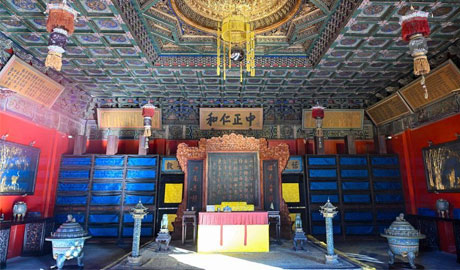
Hall of Mental Cultivation of the Palace Museum reopens to public
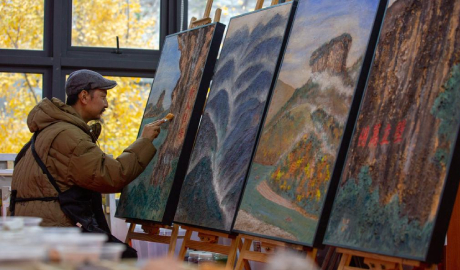
Wuyi rock pigment painting in China's Fujian infuses modern artistic elements into tradition
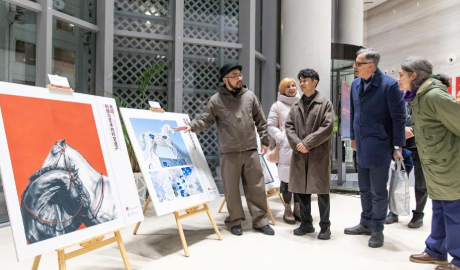
China-Serbia digital art exhibition explores time, space, heritage
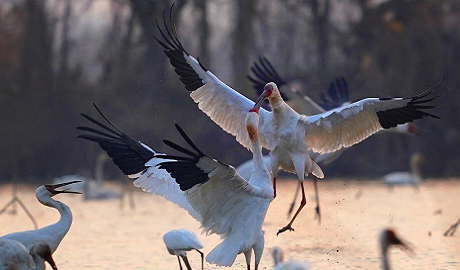
点击右上角![]() 微信好友
微信好友
 朋友圈
朋友圈

请使用浏览器分享功能进行分享
